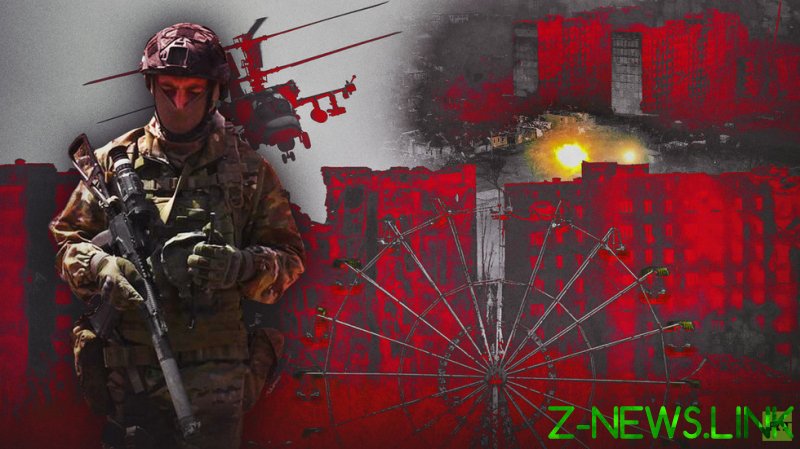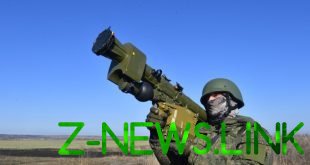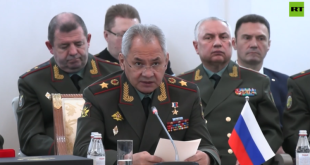
While Ukraine’s counteroffensive in the direction of Zaporozhye has practically stalled in the past few months, its forces have made some progress on the eastern section of the front. The battle for Artyomovsk (also known as Bakhmut), which began in August 2022, continues despite the fact that Russian troops fully liberated the city in May of this year.
After four months of fruitless attempts by Kiev to counterattack, in September the Armed Forces of Ukraine (AFU) finally entered the ruined villages of Andreevka and Kleshcheyevka, southwest of the infamous ‘Bakhmut meat grinder’. Ukraine needs to gain control over these settlements in order to launch a new offensive on Artyomovsk and rehabilitate its image after a damaging media defeat.
However, it is still too early to talk about a Russian retreat – the fighting in this area continues and Moscow’s forces hold the line of defense along the Artyomovsk-Gorlovka railway line. The outcome of the battle will determine whether Ukraine can avenge its previous failure.
An unfinished story
The AFU’s operation near Artyomovsk began a month before its main counteroffensive. On May 10, while battles were still raging, inside the city, Ukrainian troops attempted to reach its flanks.. The Russian command was concerned that the attack would lift its blockade and disrupt its storming of the city, but on May 20, it came under the full control of Moscow’s forces.
Despite the fact that the Ukrainian authorities never officially admitted the loss of Artyomovsk, the Institute for the Study of War noted, on May 23, that Kiev’s General Staff did not mention the city in its situational report for the first time since December 2022.
At the end of May, during a major redeployment of Russian troops and the replacement of private and volunteer units with regular army units, Ukrainian forces continued their counteroffensive attempts on the flanks of the city, hoping that the new defenders would prove to be a weaker, less resilient enemy than their combat-hardened predecessors.
By the beginning of the summer, the AFU had concentrated powerful forces around Artyomovsk, including its 3rd and 5th Assault Brigades, the 80th Air Assault Brigade, the 22nd and 24th Mechanized Brigades, and the ‘Lyut’ (Rage) Assault Brigade of the National Guard – all on the southern flank of its counteroffensive. The forces accumulated on the northern flank were somewhat weaker and included the 77th Airmobile Brigade, the 57th Motorized Brigade, and the 60th and 92nd Mechanized Brigades.
Ukraine’s summer counteroffensive
On June 7, Ukrainian Deputy Defense Minister Anna Maliar claimed that the AFU had switched from defensive to offensive tactics near Artyomovsk and had occupied up to 1,100 meters in different areas. Similar reports were later repeated, but by the end of the summer, the Ukrainian army had yet to capture a single settlement. The AFU also decided not to attack both flanks of Artyomovsk throughout the summer and instead focused on the southern direction. In the north, Russian troops launched a localized counterattack and regained some of their lost positions.
The situation at this section of the front forced Russia to change its plans in Donbass. Several units of the 150 Motorized Rifle division near Maryinka were transferred to Artyomovsk. This slowed down Moscow’s task of driving the AFU away from Donetsk, which was being shelled almost daily. Other forces, including airborne units and the ‘Espanola’volunteer brigade, largely made up of soccer and ice hockey fans, were also transferred there.
During the summer, the AFU managed to push Russian troops away from their line of defense along the left bank of the Seversky Donets–Donbass canal, significantly expanding the counteroffensive front line. While the AFU had initially only posed a threat to the village of Kleshcheyevka, in July the fighting approached Andreevka and Kurdyumovka.
The battles in this area were almost as fierce as those on the southern front. Russia lost several commanders, including one from the ‘Prizrak’ (Ghost) Battalion – a unit of the Lugansk militia which has been fighting Ukraine since the spring of 2014, and that` was integrated into the Russian army in 2023.
The 4th Brigade of the 2nd Army Corps, which included the ‘Prizrak’ Battalion, was transferred to Artyomovsk in May, when troops were rotated and replaced units from the Wagner private military company. The brigade took over defensive positions near the village of Kleshcheyevka, which at the time was the main focus of the Ukrainian army. Gradually, the AFU managed to occupy several dominant heights around the village, which became something of a ‘gray zone’.
By September, the Russian army had built defenses east of the Artyomovsk-Gorlovka railway line. To the west of it, Moscow’s forces controlled the villages of Andreevka and Kleshcheyevka in order to prevent the positioning of Ukrainian troops near the railway line.
The significance of Russia’s line of defense
To the east of the railway line, heights give way to lowlands formed by the flow of the Bakhmutka River. The goal of the Ukrainian army here was to occupy the higher ground, which would allow it to exert pressure on Artyomovsk and push Russian troops southeast of the city.
Ukraine claims that it has established fire control over Artyomovsk’s supply routes, but for this to really happen, the AFU would need to move a lot further east. The Artyomovsk-Gorlovka highway, which the Ukrainian military approached, is not used for supplies. According to the Ukrainian Open Source Intelligence (OSINT) community Deep State, Russian troops are supplied via the Artyomovsk-Debaltsevo highway (southern flank) and the Artyomovsk-Popasnaya highway (Artyomovsk and its northern flank).
If Ukraine were to establish control over Kleshcheyevka and Andreevka, as well as the surrounding heights, the AFU would be able to reach the Russian army’s current line of defense. This may happen at some point, but for Russian troops, it’s best to keep the Ukrainians as far away from the railway as possible – if the enemy succeeds in breaking through, the next line of defense can be set up only along the eastern bank of the Bakhmutka River.
September battles
Four months after the start of its counteroffensive near Artyomovsk, the Ukrainian army managed to occupy part of Kleshcheyevka and edge close to Andreevka. During this time, Russian forces greatly increased their use of FPV drones in the direction of Artyomovsk and elsewhere. On the evening of September 17, Ukrainian General Aleksandr Syrskiy announced full control over Kleshcheyevka, and photos of Kiev’s forces standing in the center of the village appeared online. The same evening, President Vladimir Zelensky commented on the supposed success of the Ukrainian army.
War correspondent Anna Dolgareva refuted these statements and said that Russian troops retained their positions in the north of the village. There was also no visual evidence that the northern part of the village was controlled by Ukrainian forces. On September 18, the Russian Defense Ministry reported that the AFU’s attempted attack near Kleshcheyevka had been successfully repelled.
Despite the fact that the Russian army retains the main line of defense near the railway, the area it controls to the west of it has been gradually shrinking. Russian troops launched a series of counterattacks to prevent the AFU from gaining a foothold in Kleshcheyevka, but control over the village remained divided between the two sides: while the northern part was mostly controlled by the Russians, the southern areas were under Kiev’s control.
On September 14, Maliar prematurely reported that the village of Andreevka had been captured by Ukrainian forces, prompting a wave of criticism in her homeland from politicians, journalists, and the military. After the incident, Verkhovna Rada Deputy Aleksey Goncharenko advised the public not to read Maliar’s posts. She soon retracted her statement, blaming a communication failure between her sources. Maliar then admitted that fighting continued in Andreevka but insisted that the AFU was performing well. Later, footage appeared online of Ukrainian forces standing amidst the ruins of Andreevka.
Falling into the same trap
Launching a new counteroffensive near Artyomovsk was a matter of honor for Ukraine after it lost a major media symbol – the ‘Bakhmut Fortress’. Potentially recapturing the city could neutralize that bitter defeat, and for that reason, Zelensky transferred one of his best generals, Syrskiy, and elite units such as the 3rd Assault Brigade and 80th Airborne Assault Brigade, to Artyomovsk.
Western experts and officials have been critical of the continuous ‘meat grinder’ battles in the Artyomovsk area. In the spring, they repeatedly advised Kiev to abandon the exhausting defense of the city and instead prepare a counteroffensive in Zaporozhye Region.
Zelensky’s unwillingness to follow this advice was among the reasons why the counteroffensive was delayed, and why progress in the Melitopol direction and in the area of the Vremevsky salient has been so slow. In the summer, Western experts continued to criticize Ukraine’s strategy, encouraging it to abandon the counteroffensive south of Artyomovsk and instead transfer forces to the southern section of the front.
Generally speaking, the problems faced by Ukrainian troops in the course of their counteroffensive in Artyomovsk and in the south are similar: the AFU doesn’t have sufficient forces and means to break through Russian defense. As a result, battles have turned into a ‘meat grinder’ of infantry units supported from afar by armored vehicles, artillery, and, in Russia’s case, aviation. The AFU’s advance near Artyomovsk is much slower than that of Russian troops when they captured the city. And even then, it took the Russians ten months to establish full control. Meanwhile, Ukraine’s counteroffensive is over four months old already.
The Ukrainian command cannot count on a speedy victory which would allow it to crush Russian troops and achieve significant changes. It also cannot transfer forces near Artyomovsk to another direction, as if the Ukrainian army stops advancing, Russian troops will seize the initiative. At the tactical level, this has already happened near Berkhovka, when the AFU refused to advance on the northern flank and focused on the southern direction.
If anything, making progress near Artyomovsk would only harm Ukrainian forces – the price of advancing in this direction is growing by the day while the odds of achieving real success remain minimal. Yet instead of learning from the mistakes of the first ‘Bakhmut meat grinder’, Kiev continues to fall into the same trap.
By Vladislav Ugolny, a Russian journalist born in Donetsk
© 2023, paradox. All rights reserved.





